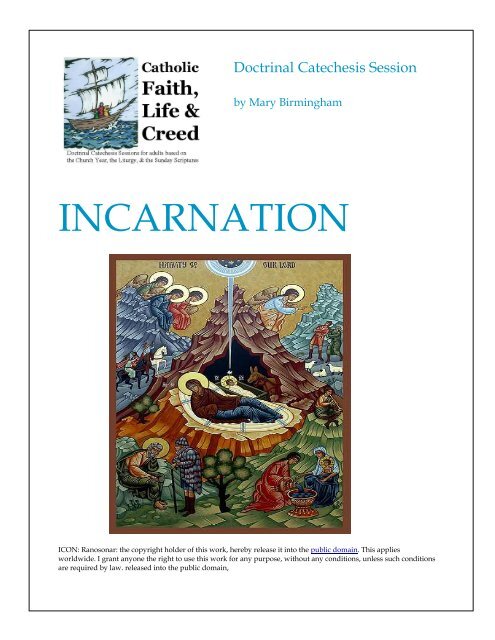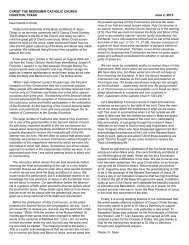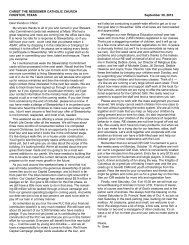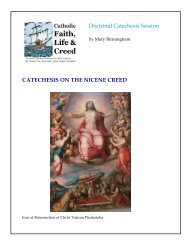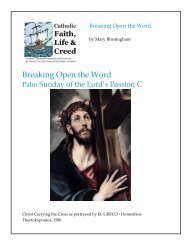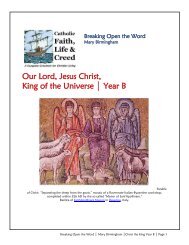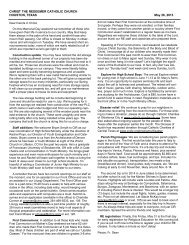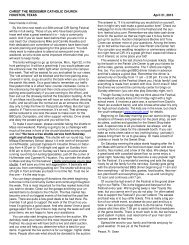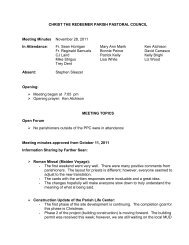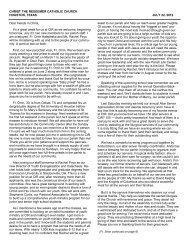MBFLC618 Incarnation - Christ The Redeemer Catholic Church
MBFLC618 Incarnation - Christ The Redeemer Catholic Church
MBFLC618 Incarnation - Christ The Redeemer Catholic Church
You also want an ePaper? Increase the reach of your titles
YUMPU automatically turns print PDFs into web optimized ePapers that Google loves.
Doctrinal Catechesis Session<br />
by Mary Birmingham<br />
INCARNATION<br />
ICON: Ranosonar: the copyright holder of this work, hereby release it into the public domain. This applies<br />
worldwide. I grant anyone the right to use this work for any purpose, without any conditions, unless such conditions<br />
are required by law. released into the public domain,
LITURGICAL CATECHESIS FLOWING FROM THE LITURGY: INCARNATION<br />
SIGN OF THE CROSS<br />
OPENING PRAYER<br />
• Option 1. Use Opening Prayer from the Sunday Liturgy.<br />
• Option 2.<br />
Prayer of Pope Clement XI<br />
Lord, I believe in you: increase my faith.<br />
I trust in you: strengthen my trust.<br />
I love you: let me love you more and more.<br />
I am sorry for my sins: deepen my sorrow.<br />
I worship you as my first beginning.<br />
I long for you as my last end.<br />
I praise you as my constant helper.<br />
And I call you as my loving protector.<br />
I want to do what you ask of me:<br />
In the way you ask, for as long as you ask, because you ask it.<br />
Let me love you Lord as my God.<br />
And see myself as I really am: a pilgrim in this world.<br />
A <strong>Christ</strong>ian called to respect and love all those lives I touch.<br />
Note to catechist: <strong>The</strong>re is more material than you can use in a one hour session.<br />
Select and arrange accordingly. Use questions and material that is best<br />
suited for your particular group.<br />
DOCTRINAL ISSUE IS NAMED.<br />
• <strong>Catholic</strong> teaching [doctrinal issue] flowing from the Liturgy of the Word is<br />
named and the reason for its choice is given.<br />
LITURGICAL CONTEXT<br />
Catechist presents the connection between the liturgy just celebrated and the<br />
doctrinal issue of the INCARNATION.<br />
Catechist reads the CONNECTING STATEMENT that connects the liturgy with<br />
this doctrinal issue. <strong>The</strong> connecting statement is found at the end of the<br />
Breaking Open the Word session for today’s liturgy.<br />
PAGE 2 OF 20 © Mary Birmingham 2010. All rights reserved.
LITURGICAL CATECHESIS FLOWING FROM THE LITURGY: INCARNATION<br />
If presented prior to <strong>Christ</strong>mas:<br />
• In these last days of Advent as we await the remembrance of the birth of <strong>Christ</strong>,<br />
it is time for us to reflect on the awesome mystery we affirm every time we<br />
gather for liturgy. We profess our faith in God who took human form, who<br />
become one with us in every way except sin in order to save the world. It is easy<br />
to give assent to this doctrine as it is so commonly professed by <strong>Christ</strong>ian<br />
traditions. Yet, how often do we take the time to really focus on the implications<br />
of this amazing saving event in human history. Today we will focus on this<br />
awesome mystery.<br />
If presented on Epiphany:<br />
• Even though there is great emphasis placed on the story of the magi, the theme<br />
of this feast transcends the manifestation of God to the gentiles and places God’s<br />
self revelation to humanity in the person of <strong>Christ</strong> front and center. This is<br />
another manifestation in a line of manifestations during the season: to the<br />
shepherds, to Mary, the Mother of God, through baptism and now to the<br />
gentiles. As the magi were considered gentiles, the feast proclaimed the<br />
manifestation of God’s mission to the gentiles; to all nations. Today’s liturgy<br />
remembers and makes present the very mystery it celebrates--the manifestation<br />
of God’s power, God’s salvation to the entire human race–the incarnation of his<br />
SON.<br />
SHARING HUMAN EXPERIENCE<br />
Catechist leads participants in a small group sharing exercise built upon the<br />
Velveteen<br />
Rabbit. Break into small groups [three or four]. Remind participants to make<br />
time for<br />
all in the group to respond to the questions.<br />
VELVETEEN RABBIT<br />
Catechist prepares for the story in these or similar words...<br />
Let us listen to a segment of the story, “<strong>The</strong> Velveteen Rabbit”. While nothing can fully<br />
capture the full meaning and implications of the <strong>Incarnation</strong> of Jesus, this story is a<br />
wonderful imaginative reminder of what the incarnation is about.<br />
PAGE 3 OF 20 © Mary Birmingham 2010. All rights reserved.
LITURGICAL CATECHESIS FLOWING FROM THE LITURGY: INCARNATION<br />
<strong>The</strong> velveteen rabbit was a saw-dust filled toy that felt that it wasn't as real as the fancy<br />
mechanical ones- until one day the toy horse tries to explain what it’s all about:<br />
Close your eyes and for one moment imagine that God is the toy horse trying to prepare<br />
Jesus, personified in the rabbit, to become human. Perhaps we can place ourselves in<br />
the story.<br />
“Real is a thing that happens to you.<br />
When a child loves you for a long time- not just to play with-<br />
But really loves you-- then you become real.<br />
(Rabbit) does it hurt?<br />
Horse: sometimes- but when you are real, you don't mind being hurt.<br />
Rabbit: does it happen all at once or bit by bit?<br />
Horse: it doesn't happen all at once. You become.<br />
It takes a long, long time.<br />
That's why it doesn't happen to people who break easily or have sharp edges or have to<br />
be carefully kept.<br />
Generally, by the time you are real,<br />
most of your hair has been loved off,<br />
your eyes drop out,<br />
you get loose joints and very shabby!<br />
But--- these things don't matter at all.<br />
Because once you're real, you can't be ugly- except to people who don't understand.”<br />
(cf. Collins, Margery. Velveteen Rabbit, Harper and Row, New York, 1922.)<br />
Catechist invites participants to respond to the following question. Break the group<br />
into dyads, then surface insights in the wider group.<br />
• Can you name a time in your life in which you loved or have been loved the way<br />
the horse describes?<br />
So, Jesus, welcome into our world! May all of us shabby rabbits with loose joints<br />
and worn hair who have been loved into reality be blessed [during this holy season]!<br />
PRESENTATION<br />
JESUS BECAME HUMAN: INCARNATION<br />
Refer to CCC: 423; 461-464; 504; USCCA: 81-87<br />
PAGE 4 OF 20 © Mary Birmingham 2010. All rights reserved.
LITURGICAL CATECHESIS FLOWING FROM THE LITURGY: INCARNATION<br />
Creedal statement.<br />
In our Nicene Creed we profess:<br />
I believe in Jesus <strong>Christ</strong>, his only Son our Lord, who was born of the<br />
Virgin Mary, suffered, died and was buried.<br />
What does the <strong>Church</strong> teach us about the <strong>Incarnation</strong> of Jesus?<br />
• Jesus was born of a virgin by the power of the Holy Spirit.<br />
• Jesus had no human father and the conception took place in the power of the<br />
Holy Spirit. Both the Gospel of Luke and Matthew attest to this. “How shall this<br />
be since I have no husband?”<br />
• In the Bible there are many cases of sterility in which God intervened in old age<br />
and a woman conceived a child (Sarah, mother of Isaac, Hannah, mother of<br />
Samuel). This was to demonstrate God’s power of salvation and redemption in<br />
seemingly impossible situations.<br />
• However, Mary was not sterile. She was fertile. She conceives not through<br />
human intercourse, but through the power of the Spirit. It is a proclamation<br />
about the power of God.<br />
• <strong>The</strong>re are two great signs of contradiction in the Gospel that begin the Jesus story<br />
and end the Jesus story–kind of like bookends to the story. Virginal conception<br />
and the empty tomb.<br />
• Both demonstrate the inability of human beings to save themselves. Human<br />
beings cannot create a savior nor can they raise themselves from the dead.<br />
• Mary said yes to God’s plan of salvation for all humanity and bore the Son of<br />
God. She is a model disciple—her “yes” should be a model for our “yes” to<br />
discipleship.<br />
• <strong>The</strong> <strong>Church</strong>’s teaching on the <strong>Incarnation</strong> is beautifully embodied in the<br />
PREFACES for the <strong>Christ</strong>mas Season.<br />
• A PREFACE is a prayer that we pray in the Mass. In that prayer we give God<br />
thanks and praise for all his saving works.<br />
• During the <strong>Christ</strong>mas season the prayer focuses on the coming of <strong>Christ</strong> as a<br />
human being---on the <strong>Incarnation</strong> of <strong>Christ</strong> and the results of that<br />
PAGE 5 OF 20 © Mary Birmingham 2010. All rights reserved.
LITURGICAL CATECHESIS FLOWING FROM THE LITURGY: INCARNATION<br />
<strong>Incarnation</strong>-what was accomplished as a result of Jesus becoming a<br />
human being.<br />
Catechist invites participants to divide into groups of four. One group reflects upon the<br />
Preface<br />
for <strong>Christ</strong>mas I, another group takes the Preface for <strong>Christ</strong>mas II, etc.<br />
Invite the people to read the preface out loud in their group and then discuss it.<br />
• What is it saying?<br />
• What does it mean?<br />
• What does it tell us about the <strong>Incarnation</strong>---that is, God taking human form in the<br />
person of Jesus <strong>Christ</strong>?<br />
• What are the implications of the <strong>Incarnation</strong>?<br />
• For example, what wonderful thing happened to human beings as a result of<br />
Jesus becoming a human being?<br />
<strong>Christ</strong>mas I<br />
Father all powerful and ever living God,<br />
We do well always and everywhere to give you thanks through Jesus <strong>Christ</strong> our Lord.<br />
In the wonder of the incarnation your eternal Word [Jesus] has brought to the eyes of<br />
faith a new and radiant vision of your glory. In him we see our God made visible and so<br />
are caught up in love of the God we cannot see...<br />
<strong>Christ</strong>mas II<br />
Father all powerful and ever living God,<br />
We do well always and everywhere to give you thanks through Jesus <strong>Christ</strong> our Lord.<br />
Today you fill our hearts with joy as we recognize in <strong>Christ</strong> the revelation of your love.<br />
No eye can see his glory as our God, yet now he is seen as one like us.<br />
<strong>Christ</strong> is your Son before all ages, yet now he is born in time.<br />
He has come to lift all things to himself, to restore unity to creation, and to lead<br />
mankind from exile into your heavenly kingdom...<br />
PAGE 6 OF 20 © Mary Birmingham 2010. All rights reserved.
LITURGICAL CATECHESIS FLOWING FROM THE LITURGY: INCARNATION<br />
<strong>Christ</strong>mas III<br />
DIVINE AND HUMAN EXCHANGE IN THE INCARNATION OF THE WORD<br />
[<strong>Christ</strong>]<br />
Father all powerful and ever living God,<br />
We do well always and everywhere to give you thanks through Jesus <strong>Christ</strong> our Lord.<br />
Today in him new light has dawned upon the world; God has become one with human<br />
beings, and human beings become one again with God.<br />
Our eternal Word [Jesus] has taken upon himself our human weakness,<br />
giving our mortal nature immortal value...<br />
So marvelous is this oneness between God and human beings that the humanity of<br />
<strong>Christ</strong> restores to humans the gift of everlasting life.<br />
Epiphany<br />
Father all powerful and ever living God,<br />
We do well always and everywhere to give you thanks through Jesus <strong>Christ</strong> our Lord.<br />
Today you revealed in <strong>Christ</strong> your eternal plan of salvation and showed him as the light<br />
of the peoples.<br />
Now that his glory has shone among us you have renewed humanity his [<strong>Christ</strong>’s]<br />
immortal image.<br />
Catechist invites each group to share some of their responses with the wider group.<br />
How did you answer the above questions?<br />
PRESENTATION<br />
• What was their preface proclaiming about the <strong>Incarnation</strong>?<br />
• What are the implications of God taking human form in the person of<br />
Jesus?<br />
• What wonderful thing happened to human beings as a result of Jesus<br />
taking human form?<br />
To affirm what you shared and to summarize what the Prefaces teach us:<br />
When the PREFACE proclaimed,<br />
PAGE 7 OF 20 © Mary Birmingham 2010. All rights reserved.
LITURGICAL CATECHESIS FLOWING FROM THE LITURGY: INCARNATION<br />
“In the wonder of the <strong>Incarnation</strong> your eternal Word has brought to the eyes of faith a<br />
new and radiant vision of your glory.”<br />
We are to understand:<br />
• Jesus, Son of God, who always was (we know that because he is referred to as the<br />
Eternal Word) took human form.<br />
• Because he took human form, it became possible for human beings to encounter<br />
the glory of God–to see God through the person (human and divine) of Jesus<br />
<strong>Christ</strong>.<br />
In the PREFACE, when it was acclaimed,<br />
“In him we see our God made visible and so are caught up in love of the God we cannot<br />
see.”<br />
We are to understand:<br />
• Jesus showed us the face of God.<br />
• Through him we are able to encounter a personal God who loves us–Jesus made<br />
an intimate relationship with God possible.<br />
• Without the <strong>Incarnation</strong> of Jesus we could not see God. Because God took<br />
human form we are privileged to now to encounter him face to face.<br />
In the Preface, when it was acclaimed,<br />
“<strong>Christ</strong> restores unity to all creation”.<br />
We are to understand:<br />
• Jesus made all creation holy by his taking human form.<br />
• All creation enjoys unity with God because it is now holy.<br />
• Jesus made it holy by his coming as a man.<br />
• This is why our <strong>Church</strong> teaches that all creation is holy. It is holy because God’s<br />
Son walked the earth and made it holy.<br />
PAGE 8 OF 20 © Mary Birmingham 2010. All rights reserved.
LITURGICAL CATECHESIS FLOWING FROM THE LITURGY: INCARNATION<br />
• All creation points to the grandeur of God.<br />
• All creation as graced, good and blessed by God because of the <strong>Incarnation</strong> of<br />
God’s Son.<br />
In the Preface when it insisted,<br />
Jesus’ resurrection brought his mission to completion. A new creation is brought to<br />
completion.<br />
We are to understand:<br />
• Sickness, suffering, mourning and death will not have the last word because we<br />
will be with <strong>Christ</strong> in his kingdom.<br />
• Ultimately, the work begun at the creation of the world is now complete.<br />
• We cannot look at the <strong>Incarnation</strong> without looking at the same time to the<br />
fulfillment of the <strong>Incarnation</strong>–the resurrection and ascension.<br />
When the preface affirmed,<br />
“No eye can see his glory as our God, yet now he is seen as one like us.”<br />
We are to understand:<br />
• We cannot readily see that Jesus is God because he is human like us.<br />
• He is God, however, and was always God’s Son.<br />
• <strong>The</strong>re was never a time when Jesus was not God.<br />
• Just as God always was and always will be, since Jesus is also God, he always<br />
was and always will be.<br />
• However, he chose to come into this world as a human being in history.<br />
PAGE 9 OF 20 © Mary Birmingham 2010. All rights reserved.
LITURGICAL CATECHESIS FLOWING FROM THE LITURGY: INCARNATION<br />
When the preface tells us,<br />
“He has come to lift up all things to himself, to restore unity to creation, and lead<br />
mankind from exile into your heavenly kingdom.”<br />
We are to understand:<br />
• Because Jesus took human form he has sanctified and made all creation holy.<br />
• Thus, we are “lifted up to Jesus”. We share in his holiness.<br />
• <strong>The</strong> purpose of the <strong>Incarnation</strong> is to lead us from this earthly plane of existence<br />
into total union with God in eternity.<br />
One of the most awesome truths of the <strong>Incarnation</strong> is in the following statement:<br />
A Divine exchange occurred.<br />
What does that mean?<br />
“Divine and human exchange in the incarnation of the Word.” And “God has become<br />
one with man and man has become one again with God.”<br />
• We should be dancing in the streets over this one principle alone….It is why Paul<br />
could tell us that we are made a little less than the angels.<br />
• Through the <strong>Incarnation</strong> of Jesus, the Eternal Word, there is a divine and human<br />
exchange.<br />
• That means that human beings are elevated to the status of divine.<br />
• We are given a divine nature and a share in eternal life because of the <strong>Christ</strong><br />
event.<br />
• Jesus made human nature holy by becoming human.<br />
• A holy exchange took place.<br />
• Jesus took human form and in turn humans were elevated and brought into<br />
union with God’s divinity.<br />
• St. Ireneus explained it well. “We become what God is, since he was made what<br />
we are" And with him we can already live from now on in that home that is the<br />
PAGE 10 OF 20 © Mary Birmingham 2010. All rights reserved.
LITURGICAL CATECHESIS FLOWING FROM THE LITURGY: INCARNATION<br />
bosom of the Father, from which he "descended" and has now "ascended,"<br />
bringing us all from the most extreme separation. (cf. Eph 4:9-10). (Ireneus,<br />
Adversus Haereses 6, Pref.; Athanasius, Epistle to Alelphium 4)<br />
• In the song, “Amazing Grace” we sing how sweet is the sound that saved a<br />
wretch like me.”<br />
• <strong>Catholic</strong> teaching insists that we are made in the image of God and that his<br />
divinity exists within us. God would hardly call those he created “wretched!”<br />
Sinners, yes, wretched, never!<br />
• Sacred Scriptures also attest to the concept of Divine Exchange that is expressed in<br />
the Preface for <strong>Christ</strong>mas. 1 John 3:2 insists that we shall be like Jesus because<br />
we shall see the truth of who he is---we will see the fullness of his divinity. A<br />
common principle in ancient Hellenistic religions was the principle that “like<br />
would know like.” Just knowing God as the divine One makes those who profess<br />
belief in him and follow him similarly divine. Since Jesus is equal with God<br />
<strong>Christ</strong>ians who call upon his name, share his legacy and live his life share in his<br />
divine life. Wretch indeed! How could those who love God and who share his<br />
divinity as a result be called wretched? To do so is an affront to God in whose<br />
image human beings are made. Sinners, yes; wretched never!<br />
WHAT FABULOUS NEWS!<br />
• Few of ourselves look at our own lives and see ourselves as divine. Yet<br />
our <strong>Church</strong> teaches that the divine spark exists in all of us. <strong>Christ</strong> gifted<br />
us with his own divinity.<br />
PAGE 11 OF 20 © Mary Birmingham 2010. All rights reserved.
LITURGICAL CATECHESIS FLOWING FROM THE LITURGY: INCARNATION<br />
Michel Sittow, 1510, public domain<br />
Catechist invites participants to engage in the following reflection that consists of two<br />
parts. Do not move to part two until the small groups have had the opportunity to<br />
respond to part one.<br />
Part one:<br />
Choose one person you know--a loved one, a friend, an acquaintance. In looking at<br />
them, how would you describe the divine spark that is within them? What evidence is<br />
there that the person you describe has divine life within? What about them exudes the<br />
holiness of God?<br />
Reflect and share in small group, the surface insights in the wider group.<br />
Part Two:<br />
Now that you have had practice in looking at the divinity within another person,<br />
consider the same question in relation to yourself.<br />
How would you describe the divine spark that is within you?<br />
What evidence is there that <strong>Christ</strong>’s own divinity resides within you?<br />
What about you exudes the holiness of God?<br />
Reflect and share in small group and surface insights in wider group. How easy or<br />
difficult was this reflection? What did we learn from this reflection about ourselves?<br />
PAGE 12 OF 20 © Mary Birmingham 2010. All rights reserved.
LITURGICAL CATECHESIS FLOWING FROM THE LITURGY: INCARNATION<br />
Ultimately the Preface teaches us:<br />
“Your eternal Word has taken upon himself our human weakness, giving our mortal<br />
nature immortal value. So marvelous is this oneness between God and man that in<br />
<strong>Christ</strong> man restores to man the gift of everlasting life.”<br />
• Jesus took on human form with all its weaknesses and in so doing made<br />
humanity immortal beings–made it possible for human beings to share in eternal<br />
life--made it possible for us to enter heaven!<br />
What a tremendous gift we have been given!<br />
Implications:<br />
• We are invited to participate in Jesus’ <strong>Incarnation</strong> each and every day.<br />
• We are invited into his Paschal Mystery–to grow in holiness–to become real and<br />
authentic and cooperate and grow into the gift of divinity we have been given<br />
(and to acknowledge and appreciate that same gift in others).<br />
• Emphasize: We are called to die and rise (the ultimate goal of Jesus’<br />
<strong>Incarnation</strong>) –to become vulnerable to one another as <strong>Christ</strong> was vulnerable<br />
for us through his incarnation.<br />
• We are challenged to allow <strong>Christ</strong> to come to birth in our lives each and every<br />
day. We are challenged to embrace our divine nature, understand that we are<br />
“good” and to share that goodness with the world.<br />
For an optional story of the importance of INCARNATION see Appendix #1.<br />
IMPLICATIONS FOR DISCIPLESHIP<br />
• <strong>The</strong> <strong>Incarnation</strong> was not a one-time event in history.<br />
• <strong>The</strong> <strong>Incarnation</strong> of <strong>Christ</strong> continues in us today as we constantly bring him to<br />
rebirth in our lives.<br />
• Jesus chose to love us unto death–he became one with us and invites us into his<br />
life. He invites us to celebrate his presence during his absence.<br />
• <strong>The</strong> <strong>Incarnation</strong> continues every time we submit to the will of <strong>Christ</strong> in our lives.<br />
He is born anew within us.<br />
PAGE 13 OF 20 © Mary Birmingham 2010. All rights reserved.
LITURGICAL CATECHESIS FLOWING FROM THE LITURGY: INCARNATION<br />
CONNECTING LITURGY AND SCRIPTURE TO EVERYDAY LIFE<br />
Catechist invites participants to reflect on the power of the <strong>Incarnation</strong> to transform<br />
their lives. Catechist witnesses to a story in his or her life or invites another parishioner<br />
to witness, then invite participants to witness to one another. See appendix #2 for an<br />
example.<br />
• How does Jesus’ <strong>Incarnation</strong> relate to your life---to an experience in your life?<br />
• How does it relate to what is going on in our world right now? [Lack of health<br />
care, joblessness, war, etc.]<br />
COMMUNITY CONNECTION<br />
Liturgy, scripture and doctrine challenge us to transform our lives so that we can go out<br />
and help transform the world.<br />
Catechist informs the group of any parish activity and makes arrangements of group<br />
participation.<br />
What is taking place in the parish community this week/season that would challenge<br />
us to participate in bringing <strong>Christ</strong> to birth in the life of the poor, oppressed,<br />
marginalized, the lonely, and disenfranchised?<br />
Our social concerns center provides, food, clothing and household needs to the poor in<br />
our area. <strong>The</strong>y are looking for volunteers to help at the center. We will meet at the<br />
center this Tuesday evening at 6:00.<br />
DECISION FOR CHANGE<br />
Catechist invites participants to respond to the following challenge by<br />
sharing with one other person.<br />
In what way does this teaching on the <strong>Incarnation</strong> of <strong>Christ</strong> challenge you and<br />
the<br />
<strong>Christ</strong>ian community?<br />
In what way does today’s session challenge you to change?<br />
PAGE 14 OF 20 © Mary Birmingham 2010. All rights reserved.
LITURGICAL CATECHESIS FLOWING FROM THE LITURGY: INCARNATION<br />
Is there a behavior or attitude in need of transformation?<br />
What are you willing to commit to do in response to what you learned<br />
about the <strong>Incarnation</strong>---what are the implications for your life?<br />
JOURNAL<br />
Questions for your journal throughout the week: Continue to reflect on<br />
the evidence of <strong>Christ</strong>’s divine life within you as a result of the<br />
<strong>Incarnation</strong>.<br />
If <strong>Christ</strong> sanctified [made holy] the earth by coming as a human being,<br />
how does that reconcile with the present state of the world? What<br />
evidence is there in the world that all creation is sanctified as a result of<br />
the <strong>Incarnation</strong>?<br />
CONCLUDING PRAYERS.<br />
Read Luke 1: 26-35<br />
Option 1: If this is a catechumenal session, end the session with<br />
Intercessions, Doxology [“Glory be to the Father…”], a minor rite—<br />
a blessing or minor exorcism, RCIA # 90-97.<br />
Option 2: include intercessions and sign of peace.<br />
PAGE 15 OF 20 © Mary Birmingham 2010. All rights reserved.
#1.<br />
LITURGICAL CATECHESIS FLOWING FROM THE LITURGY: INCARNATION<br />
APPENDIX<br />
An Irish author of an intriguing travel guide of Ireland in his book, “<strong>The</strong> Secret Places<br />
of the Burren” tells of an encounter with two men he met during his travels across<br />
Ireland. One was a brilliant nuclear physicist and the other a distinguished doctor. Both<br />
were in their early thirties, unmarried and both joined contemplative orders. <strong>The</strong>y<br />
shared what motivated their decision to join the contemplative order. <strong>The</strong>ir story gave<br />
this author a glimpse into the meaning of life itself. It can be summed up in the words<br />
of a wonderful Benedictine monk, “it’s the <strong>Incarnation</strong>, silly!”<br />
<strong>The</strong> men told him: “<strong>The</strong> human being exists solely for the purpose of becoming an<br />
earthly life form of God. God exists in the human being. Thus, inner dimension of man<br />
should rule his life, and that inner dimension is God. Everything else was a mere side<br />
show. One lives a life in practical terms in as close a union as possible with God—not<br />
for a reward. One did it because this is the only rational explanation of life itself, the<br />
only explanation that gives meaning to death. A life lived in those terms brings<br />
unbelievable happiness”, said the monks.<br />
<strong>The</strong>y made an analogy, “A stained glass window looked at from the outside is merely a<br />
grayish glaze. But looked at from the inside is a thing of indescribable beauty. If you<br />
are on the inside you can experience everything to its fullest. If we accept the ‘inner’ life<br />
it does not really matter whether or not we are in a monastery---fulfillment of life’s<br />
purpose will be ours. <strong>The</strong> <strong>Incarnation</strong> is alive in us.<br />
Both men are now dead. One gave up world-wide fame, the other great wealth.<br />
Neither would concede that they gave up anything. <strong>The</strong>y would contend that they<br />
gave up trash for everything. Indeed both were two of the happiest men I ever knew.”<br />
(John M. Feehan, <strong>The</strong> Secret Places of the Burren, Published in 1991, Royal Carbery (Cork)<br />
P. 106, 107)<br />
PAGE 16 OF 20 © Mary Birmingham 2010. All rights reserved.
LITURGICAL CATECHESIS FLOWING FROM THE LITURGY: INCARNATION<br />
#2.<br />
When the Preface affirms that a divine/human exchange took place as a result of the<br />
<strong>Incarnation</strong>, I am touched to the core of my being. I have the personal privilege of<br />
experiencing the absolute truth of that statement first hand. It is very Good News for<br />
me and Good News that I am called upon to remember over and over again. I have a<br />
child with schizophrenia. <strong>The</strong>re are times in the course of this disease when he is very<br />
ill. During those times he experiences delusions that tell him he is God. In the midst of<br />
this strange insanity he has taught me what this divine exchange is really all about.<br />
Because the illness has stripped him of what most young men his age are normally<br />
concerned about---all superfluous desires are stripped away and we who love him are<br />
given a glimpse into his soul. In the midst of these periodic bouts of insanity lies a<br />
foundational kernel of truth---his intimate relationship with God--the divinity that<br />
glimmers within yet is so hard to see since during those times he looks so unlike the rest<br />
of us as he bears all the physical manifestations of mental illness that have become so<br />
common place and yet so dismissed and overlooked in our culture. We see the<br />
mentally ill, but we choose not to really “see” them.<br />
<strong>The</strong> true divinity that is within him sparkles like the sunshine on his best days. Indeed<br />
there is a divine spark within. When one listens to the wisdom that flows from him<br />
when he is in his “god-mode” one marvels at this lowly creature of God. This amazing,<br />
poor one of God--anawin--was expelled from his home parish chapel because of his<br />
frightening appearance. <strong>The</strong>y could not recognize the young man they knew so well<br />
who grew up as a normal child and active parishioner in their midst. All they saw was<br />
this broken homeless-looking person who invaded their prayer space. This person who<br />
at times appears so lowly in the eyes of the world, believes that the most important<br />
reason for his/our/human existence is complete union with God.<br />
Lest I imply any illusions about his condition--it is a nightmare disease. It literally has<br />
broken the hearts of each member of our family. He has been medicine compliant now<br />
for over a year and we are thanking God for this miracle. Within our own family<br />
structure we are given the rare opportunity to experience the divine person who comes<br />
to us as this very ill person, lowly much like those first lowly witnesses to the birth of<br />
<strong>Christ</strong>. Over the course of his illness when I thought I could take no more, I was<br />
reminded of this child in whom the divinity of <strong>Christ</strong>---the suffering <strong>Christ</strong> on the cross<br />
is so manifest to us and I try very hard to give thanks for this rare opportunity to love<br />
with a love made possible only by the <strong>Incarnation</strong> of <strong>Christ</strong>.<br />
PAGE 17 OF 20 © Mary Birmingham 2010. All rights reserved.
LITURGICAL CATECHESIS FLOWING FROM THE LITURGY: INCARNATION<br />
Handout: Prefaces for the <strong>Christ</strong>mas Season<br />
<strong>Christ</strong>mas I<br />
Father all powerful and ever living God,<br />
We do well always and everywhere to give you thanks through Jesus <strong>Christ</strong> our Lord.<br />
In the wonder of the incarnation your eternal Word [Jesus] has brought to the eyes of<br />
faith a new and radiant vision of your glory. In him we see our God made visible and so<br />
are caught up in love of the God we cannot see...<br />
<strong>Christ</strong>mas II<br />
Father all powerful and ever living God,<br />
We do well always and everywhere to give you thanks through Jesus <strong>Christ</strong> our Lord.<br />
Today you fill our hearts with joy as we recognize in <strong>Christ</strong> the revelation of your love.<br />
No eye can see his glory as our God, yet now he is seen as one like us.<br />
<strong>Christ</strong> is your Son before all ages, yet now he is born in time.<br />
He has come to lift all things to himself, to restore unity to creation, and to lead<br />
mankind from exile into your heavenly kingdom...<br />
<strong>Christ</strong>mas III<br />
DIVINE AND HUMAN EXCHANGE IN THE INCARNATION OF THE WORD<br />
[<strong>Christ</strong>]<br />
Father all powerful and ever living God,<br />
We do well always and everywhere to give you thanks through Jesus <strong>Christ</strong> our Lord.<br />
Today in him new light has dawned upon the world; God has become one with human<br />
beings, and human beings become one again with God.<br />
Our eternal Word [Jesus] has taken upon himself our human weakness,<br />
giving our mortal nature immortal value...<br />
So marvelous is this oneness between God and human beings that the humanity of<br />
<strong>Christ</strong> restores to humans the gift of everlasting life.<br />
Epiphany<br />
Father all powerful and ever living God,<br />
We do well always and everywhere to give you thanks through Jesus <strong>Christ</strong> our Lord.<br />
Today you revealed in <strong>Christ</strong> your eternal plan of salvation and showed him as the light<br />
of the peoples.<br />
Now that his glory has shone among us you have renewed humanity his [<strong>Christ</strong>’s]<br />
immortal image.<br />
PAGE 18 OF 20 © Mary Birmingham 2010. All rights reserved.
LITURGICAL CATECHESIS FLOWING FROM THE LITURGY: INCARNATION<br />
Handout: If the session on the <strong>Incarnation</strong> is given during the <strong>Christ</strong>mas season the<br />
following handout may be useful.<br />
Scripture: Matthew’s Genealogy Mt. 1: 1-25 This scripture tells us a great deal about<br />
the implications of Jesus becoming a human being. Read the Scripture passage.<br />
Joseph is not the biological father, but he is the legal father of Jesus. <strong>The</strong> Messiah was<br />
destined to come from the house of David. Joseph is the rightful heir of the House of<br />
David since his ancestry could be traced back to David. In other words, Jesus possessed<br />
the necessary pedigree.<br />
<strong>The</strong> genealogy is proclaimed at <strong>Christ</strong>mas to emphasize how God writes salvation<br />
history with a crooked pen. <strong>The</strong> story includes an infamous cast of characters--some<br />
remarkable, some very forgettable. <strong>The</strong>y all had a place in God’s story of salvation–as<br />
do we.<br />
<strong>The</strong> people expected a warrior king; they got a lowly carpenter’s son. <strong>The</strong>y expected a<br />
mighty earthly reign from a throne of might; they got the degradation of the cross–the<br />
throne of our salvation. <strong>The</strong>y expected a victorious king and warrior; they got a servant<br />
who was victorious in defeat. From the very beginning God used people who would<br />
never pass the test of righteousness in his plan of salvation. It includes scoundrels,<br />
prostitutes, scoundrel kings and the famous King David. Jesus, like us, comes from a<br />
soiled family tree–he understands sins inherited from one generation to the next.<br />
If God chose saints and sinners, so, too, would Jesus. We are reminded that God<br />
continues to work with our shortcomings. <strong>The</strong> genealogy portrays God’s incredible<br />
grace poured out on the world–unmerited grace. <strong>The</strong> genealogy is an invitation to<br />
know that we cannot earn salvation–that God works in spite of us–that God chooses<br />
whom God wills and uses whom God chooses to accomplish his work.<br />
In spite of a sordid past, a family tree of shame, oppression, abuse and the like, one<br />
would rise up in the midst of it- to free us from it. <strong>The</strong> genealogy speaks to those of us<br />
who must work out our own issues of painful family memories, of oppression and<br />
abuse. <strong>The</strong>re is one who has come before us and who frees us from our past--to break<br />
the chain of oppression and be an agent of healing. God will use us in the same way if<br />
we cooperate with him. No child of God is insignificant or unforgettable. Every person<br />
has a role in God's plan to continue the <strong>Incarnation</strong> of his Son.<br />
PAGE 19 OF 20 © Mary Birmingham 2010. All rights reserved.
LITURGICAL CATECHESIS FLOWING FROM THE LITURGY: INCARNATION<br />
Anointing of the Sick and Dying - and the use of Viaticum<br />
Baptism<br />
<strong>Catholic</strong> Social Teaching<br />
<strong>The</strong> <strong>Church</strong> & Ecclesiology<br />
<strong>Church</strong> Structures<br />
Confirmation<br />
<strong>The</strong> Cross and the Paschal Mystery<br />
Ecumenism<br />
Eschatology or the End Times<br />
<strong>Incarnation</strong><br />
Eucharist (part one): the Introductory Rites<br />
Eucharist (part two): the Liturgy of the Word<br />
Eucharist (part three): the Eucharistic Prayer<br />
Eucharist (part four): Communion Rite<br />
Eucharist: Symbols of Bread and Wine<br />
Evangelization<br />
Faith<br />
Kingdom of God<br />
Life Issues<br />
<strong>The</strong> Liturgical Year<br />
Marriage<br />
Mary, Model for the <strong>Church</strong><br />
Miracles<br />
Morality<br />
Moral Decision Making<br />
Holy Orders<br />
Advent (an overview)<br />
<strong>Christ</strong>mas (an overview)<br />
Lent (an overview)<br />
<strong>The</strong> Easter Season (an overview)<br />
Triduum (an overview)<br />
Prayer<br />
Reconciliation<br />
Sacraments<br />
Saints<br />
Scripture and Revelation (part one)<br />
Scripture and Revelation (part two)<br />
Sin and Grace<br />
Soteriology and Salvation<br />
Stewardship<br />
PAGE 20 OF 20 © Mary Birmingham 2010. All rights reserved.<br />
Comprehensive List of all the<br />
Topics treated in this series


